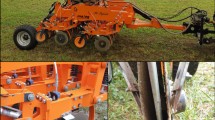Abstract
In last years Dimilin showed high efficiency against free feeding larvac of Lepidoptera and Tenthredinidae injurious to forests. Arthropods sucking plant sap or living hidden at plants can not be reached by this substance. However some species of nematodes living ectoparasitic on roots are susceptible. Dimilin does'nt belong to a poison-class. It is'nt toxic to plants and to bees.
Adult insects are influenced by Dimilin in the direction of decreasing the reproduction. The substance is ovicide against fresh laid insect eggs.
Some side effects of Dimilin injuring the ecosystem are the long termed persistence and the destroying of phytophagous larvae which are economic indifferent. Further studies must show wether the soil fauna is affected by control measures using Dimilin.
Zusammenfassung
Der Häutungshemmstoff Dimilin hat sich im Waldschutz gegen freifressende Schmetterlings- und Blattwespenlarven hervorragend bewährt. Gegen saugende und versteckt fressende Gliederfüßler ist er unwirksam. Er gehört keiner Giftklasse an, ist nicht phytotoxisch und ist bienenungefährlich. Auch ein Teil der Wurzelnematoden kann mit ihm bekämpft werden.
Bei phytophagen Insekten-Imagines kann Dimilin zur Verminderung der Reproduktionsrate führen. Gegen frisch abgelegte Arthropoden-Eier wirkt Dimilin ovizid.
Den zahlreichen positiven Eigenschaften des Dimilins stehen als unerwünschte Nebenwirkungen vor allem seine Persistenz sowie die Häutungshemmung auch bei indifferenten phytophagen Larven gegenüber. Ob und wieweit unter normalen Bekämpfungsbedingungen Teile der Bodenfauna durch Dimilin beeinträchtigt werden, müssen künftige Untersuchungen zeigen. Die Wahrscheinlichkeit hierzu ist sehr gering.
Similar content being viewed by others
Literaturverzeichnis
Ables, J. R.;Jones, S. L.;Bee, M. J., 1977: Effect of diflubenzurol on beneficial arthropods associated with cotton. Southwest Entomologist2 (2), 66–72.
Ascher, K. R. S.;Nemny, N. E., 1974: The Oocidal Effekt of PH 60-40 inSpodoptera littoralis Boisd. Phytoparasitica2 (2), 131–133.
Barker, R. J.;Waller, G. D., 1978: Effects of diflubenzuron wettable powder on caged honey bee colonies. Environm. Ent.7 (4), 534–535.
Bogenschütz, H., 1976: Einige Untersuchungen zur Wirkung von Dimilin auf forstliche Schad- und Nutzinsekten. Forstpfl., Forstsamen16 (2), 13–15.
Doppelreiter, H., 1979: Zur Biozidempfindlichkeit von Collembolen im Fichtenwaldboden. Zt. ang. Ent.87 (im Druck).
Egger, A., 1977: Die Nebenwirkungen von Dimilin auf Bienen, eine Untersuchung anläßlich einer Flugzeugapplikation im Forst. Cbl. ges. Forstwesen94 (2), 65–72.
Ellis, H; Diepering, J. G., 1974: Practical Experiences with the Experimental Insecticide PH 60-40. 26th Int. Symp. on Crop Protect. Gent.
Fogal, W. H., 1977: Effect of a phenyl-benzoyl urea onDiprion similis (Hym., Diprionidae). Canad. Ent.109 (7), 981–986.
Granett, J.;Weseloh, R. M., 1975: Dimilin toxicity to the gypsy moth larval parasitoid,Apanteles melanoscelus. J. ec. Ent.68 (5), 577–580.
Hartinger, C., 1976: Zur Wirkung des Entwicklungs-hemmers Dimilin auf Gespinstmotten (Yponomeuta spp.) und ihre Parasiten. Anz. Schädlingsk., Pflanzensch., Umweltschutz49, 156–158.
Holst, H., 1975: Die fertilitätsbeeinflussende Wirkung des neuen Insektizids PDD 60-40 beiEpilachna varivestis Muls. (Col., Coccinellidae) undLeptinotarsa decemlineata Say. (Col., Chrysomelidae). Z. f. Pflanzenkr. u. Pfl. Schutz82, 1–7.
Ishaaya, I.;Ascher, K. R. S., 1978: Effect of diflubenzuron on growth and carbohydrate hydrolases ofTribolium castaneum. Phytoparas.5 (3), 149–158.
Keever, D. W.;Bradley, J. R.;Ganyard, M. C., 1977: Effects of Diflubenzuron (Dimilin) on selected beneficial arthropods in cotton fields. Environm. Ent.6 (5), 732 bis 736.
Keller, S., 1978: Untersuchungen über den Einfluß von Dimilin (Diflubenzuron) auf Wachstum und Konidienkeimung einiger insektenpathogener Pilze. Anz. Schädl., Pfl. Schutz, Umw. Schutz51, 81–83.
Kiziroglou, I., Zur Kenntnis der Fliedermotte,Gracilaria syringella F. (Lep., Gracilariidae), mit Berücksichtigung der Massenvermehrung 1973 und 1974. Z. ang. Eng.80, 407–426;81, 43–61, 163–187.
Mitlin, N.;Wiygul, G.;Haynes, J. W., 1977: Inhibition of DNA synthesis in boll weevils (Anthonomus grandis Boh.) sterilized by Dimilin. Pest. Biochem. and Physiol.7 (6), 559–563.
Monaco, R.;Triggiani, O., 1977: Prova di efficacia des Bacillus thuringiensis des Dimilin nei riguardi desPrays oleae. Inform. Fitopatol.27 (4), 9–11.
Moore, K. M.;Taft, H. M., 1975: Boll weevils: Chemosterilization of both sexes with bisulfan plus Thompson-Hayward TH 60-40. J. econ. Ent.68, 96–98.
Mulder, R.;Gijswijt, M. J., 1973: The Laboratory Evaluation of Two Promosing New Insecticides which Interfere with Cuticle Deposition. Pestic. Scient.,4, 731–745.
Naton, E., 1978: Zur Prüfung der Nebenwirkung von Pflanzenschutzmitteln auf Nutzarthropoden an der lebenden Pflanze. Die Prüfung mitPhygadeuon trichops. Anz. Schädlingskde.51 (9), 136–139.
Post, L. C.;Vincent, W. R., 1973: A New Insecticide Inhibits Chitin Synthesis. Naturwiss.60, 431–433.
Post, L. C.;de Jong, B.;Vincent, W. R., 1974: 1-(2,6-Disubstituted-Benzoyl)-3-Phenylurea Insecticides: Inhibitors of Chitin Synthesis. Pesticide Biochem. and Physiol.4, 473–483.
Salama, H. S.;Motagally, Z. A.;Skatulla, U., 1976: On the Mode of Action of Dimilin as a Moulting Inhibitor in some Lepidopterous Insects. Zt. ang. Ent.80, 396 bis 407.
Salem, F. M., 1979: Efficacy of an insect growth regulator, Dimilin, on Nematode community in Maize field. Anz. Schädl., Pfl. Schutz, Umw. Schutz52 (im Druck).
Skatulla, U., 1975: Über die Wirkung des Entwicklungs-hemmers Dimilin auf Forstinsekten. Anz. Schädlingsk., Pfl. Schutz, Umw. Schutz48, 145–147.
Skatulla, U., 1976: Dimilin, ein Insektizid mit völlig neuem Wirkungsmechanismus für den Forst. Forstpfl., Forstsamen16, 10–12.
van Busschbach, E. J., 1976: Dimilin, ein für die forstliche Praxis vielversprechendes Insektizid. Forstpfl., Forstsamen16 (2), 9.
van Daalen, J. J.;Meltzer, J.;Mulder, R.;Wellinga, K., 1972: Selective Insecticide with a Novel Mode of Action. Naturwiss.59, 312–313.
Weiss, M., 1977: Zur Wirkung von Dimilin auf die Imagines und Eier des Erlenblattkäfers,Agelastica alni L. (Col., Chrysomelidae). Anz. Schädlingsk., Pfl. Schutz, Umw. Schutz50 (11), 161–164.
Wellinga, H.;Mulder, R.;van Daalen, J. J., 1973: Synthesis and Laboratory Evaluation of 1-(2,6-Disubstituted Benzoyl)-3-Phenylureas, a New Class of Insecticides. J. Agr. Food Chem.21, 348–354.
Author information
Authors and Affiliations
Rights and permissions
About this article
Cite this article
Schwenke, W. Über die Rolle des Häutungshemmstoffes Dimilin im Waldschutz und Waldökosystem. Anz. Schadlingskde., Pflanzenschutz, Umweltschutz 52, 97–102 (1979). https://doi.org/10.1007/BF01957710
Issue Date:
DOI: https://doi.org/10.1007/BF01957710




